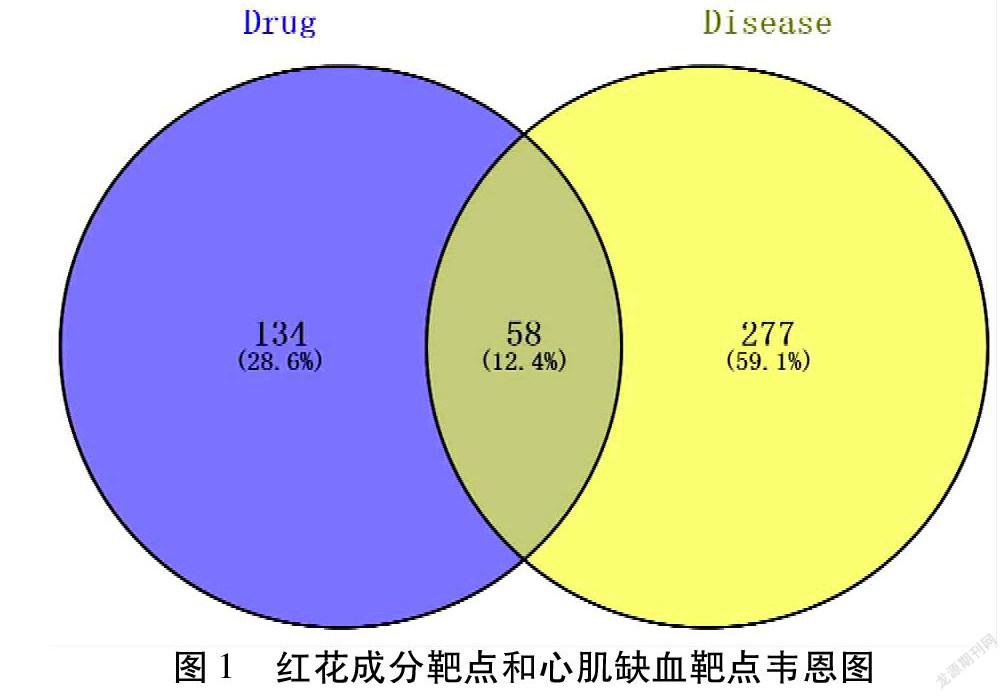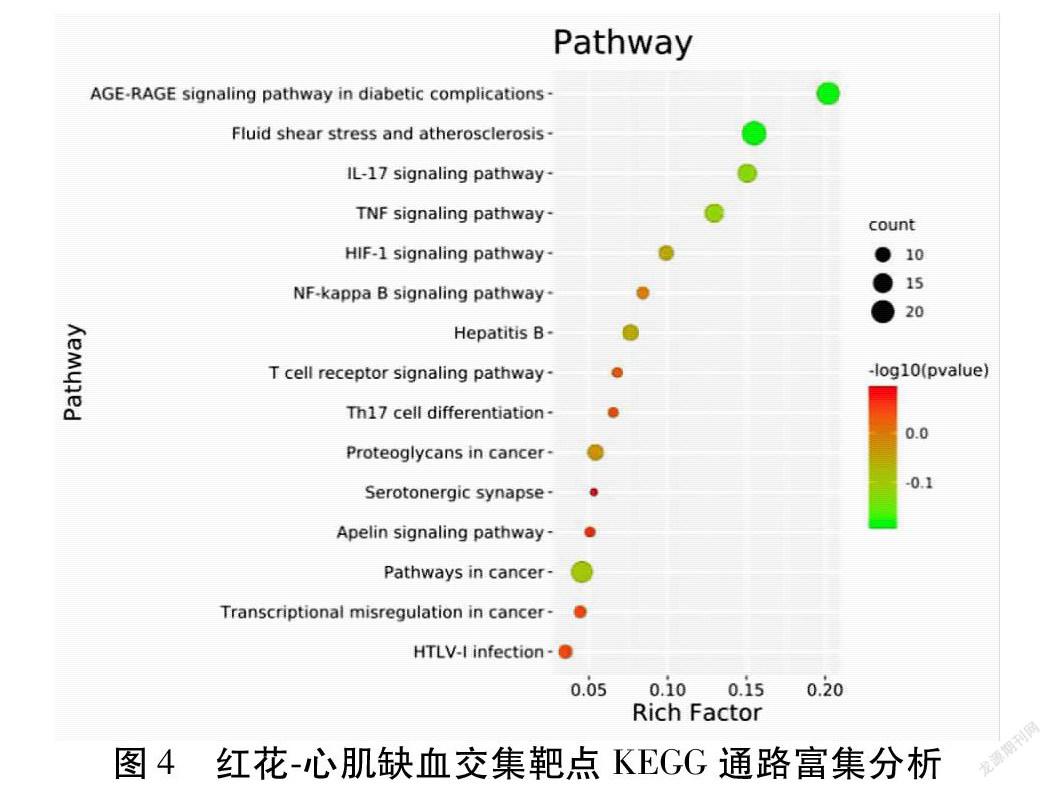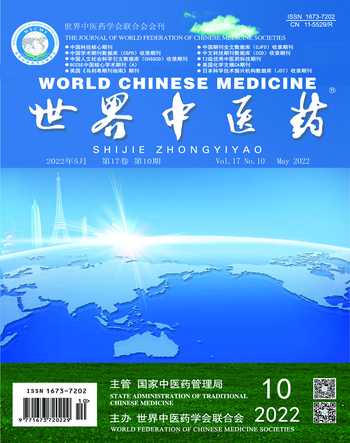基于网络药理学研究红花抗心肌缺血的作用机制
李文静 王艳萍 洪博







摘要 目的:构建红花药材-成分-靶点-通路网络,探讨红花治疗心肌缺血的作用机制。方法:以红花中符合口服生物利用度(OB)≥30%、类药性(DL)≥0.18的化合物作为研究对象,通过中药系统药理学数据库与分析平台(TCMSP)對进行检索并得到靶点,并在UniProt数据库靶点检索基因名,通过GeneCards数据库对心肌缺血进行检索,得到心肌缺血靶点。将心肌缺血与红花靶点取交集。将所得到交集靶点进行蛋白质-蛋白质相互作用(PPI)分析、基因本体(GO)富集分析和京都基因和基因组百科全书(KEGG)富集分析。利用Cytoscape 3.8.0软件绘制药材-化合物-靶点-通路网络图。结果:得到红花16个活性成分,192个靶点,在GeneCards数据库搜索并筛选得到335个心肌缺血靶点。得到红花靶点与心肌缺血交集靶点58个。交集靶点PPI度值排名前3位为IL6、TNF、VEGFA。GO与KEGG通路富集分析分别选取前5个条目绘制气泡图。药材-化合物-靶点-通路网络中有89个节点,338条边。节点前三的化合物为:槲皮素、山柰酚与木犀草素。结论:红花可能通过多种化学成分、多靶点与多途径起到治疗心肌缺血的作用,为其在临床使用提供理论依据。
关键词 红花;心肌缺血;冠状动脉粥样硬化心脏病;网络药理学;流体剪应力;槲皮素;通路网络;作用机制
Study on the Mechanism of Carthamus tinctorius in Treatment of Myocardial Ischemia Based on Network Pharmacology
LI Wenjing,WANG Yanping,HONG Bo
(Department of Pharmacy,Qiqihar Medical University,Qiqihar 161006,China)
Abstract Objective:To construct Carthamus tinctorius medicinal material composition-target-pathway network and to explore the mechanism of Carthamus tinctorius in the treatment of myocardial ischemia.Methods:The compounds in Carthamus tinctorius which met OB≥30%,DL≥0.18 were taken as the research objects.The components and targets which met the requirements were searched by TCMSP Database,and the gene names of the targets were searched in UniProt Database.The myocardial ischemia targets were obtained by searching for myocardial ischemia in GeneCards Database.The intersection of myocardial ischemia target and Carthamus tinctorius target was obtained.The intersection targets were analyzed by PPI and GO and KEGG pathways.Cytoscape 3.8.0 software was used to draw the network diagram of medicinal drug-compound-target-pathway.Results:There were 16 active compounds and 192 targets in Carthamus tinctorius,and 335 targets of myocardial ischemia were obtained by searching for myocardial ischemia in GeneCards.Taking Carthamus tinctorius target and myocardial ischemia target as intersection,58 intersection targets were obtained.PPI analysis was performed on the intersection targets,and the top 3 targets with PPI score were:IL6,TNF,and VEGFA.The enrichment analysis of GO and KEGG pathways selected the first 5 entries to draw bubble charts.There were 89 nodes and 338 edges in the medicinal material-compound-target-pathway network.The top 3 compounds at the node were:quercetin,kaempferol and luteolin.Conclusion:Carthamus tinctorius may play a role in the treatment of myocardial ischemia through various chemical components,multiple targets and multiple ways,which provides theoretical basis for its clinical use.
Keywords Carthamus tinctorius; Myocardial ischemia; Coronary atherosclerotic heart disease; Network pharmacology; Fluid shear stress; Quercetin; Pathway network; Mechanism
中图分类号:R256.22;R285文献标识码:Adoi:10.3969/j.issn.1673-7202.2022.10.005
心肌缺血(Myocardial Ischemia),是指心肌供血不足,随之导致严重的并发症且危及生命的疾病[1]。引起心肌缺血的原因主要有:主动脉供血减少、血黏度的变化、炎症、冠脉阻塞以及心肌本身的病变等[2]。这些原因会导致心脏遭受急性缺血再灌注损伤,最终导致心律失常、心力衰竭和死亡[3]。心肌缺血在临床上属于冠状动脉粥样硬化心脏病(Coronary Atherosclerotic Heart Disease,CAHD)即冠心病,主要是因为体内脂质代谢异常导致血管内脂质沉积并形成粥样白色斑块,最后导致血容量减少,血液循环受阻,继而使心肌缺血或缺氧[4]。据报道,2016年冠心病导致了948万人死亡,且每年与冠心病相关的死亡有1 750万人,占全球死亡率的31%[5-6]。心肌缺血还对冠心病预后产生不良影响[7]。红花(Carthamus tinctorius L.),是菊科植物红花的干花,红花性温味辛,有活血化瘀、通经止痛的功效。红花中化学成分主要有黄酮类、甾体类等,其中主要的活性成分为红花黄色素、山柰酚等[8]。研究表明,红花能通过使冠脉阻力降低,冠脉流量增加,还能清除自由基,抑制氧化应激、改善能量代谢障碍,并抑制炎症等,应用于治疗心血管疾病患者[9-12]。网络药理学是药理学的一门分支学科,是采用药理学、生物信息学等方法对药物与疾病之间的成分、靶点以及信号通路进行分析[13]。体现了中医的整体性和相互作用关系的原则,本研究基于此原则,通过网络药理学的分析方法,对红花治疗心肌缺血的药材-化合物-靶点-通路复杂网络进行探讨,从多个角度分析其作用机制,为红花的进一步研究提供理论依据。
1 资料与方法
1.1 红花活性化合物与靶蛋白的收集与筛选 以红花为关键词,通过中药系统药理学数据库与分析平台(Traditional Chinese Medicine Systems Pharmacology Database and Analysis Platform,TCMSP)检索红花活性化合物。吸收、分布、代谢和排泄是药理学研究中用于选择药物的一个模型,口服生物利用度(Oral Bioavailability,OB)是口服药物的一个基本参数,用于评估药物在体内的药物动力学和药物形成特性。OB值越高表明药物的生物活性越好,类药性(Drug Likeness,DL)与之相似,也是药动学的重要参数之一。本研究中通过OB≥30%,DL≥0.18对进行红花中的活性成分进行筛选,并得到活性化合物中的相关靶蛋白。得到的靶蛋白在UniProt数据库进行基因名的转换。
1.2 心肌缺血靶点的收集 通过GeneCards数据库,以“myocardial ischemia”为关键词进行检索,得到心肌缺血相关靶点,选取得分≥10的靶点作为本研究的心肌缺血靶点。
1.3 药物靶点与疾病靶点的映射 将1.1项下与1.2项下所得的药物与疾病靶点输入Venny 2.1在线软件作图工具平台(https://bioinfogp.cnb.csic.es/tools/venny/)中,绘制韦恩图并得到药物与疾病靶点的交集基因。
1.4 蛋白质-蛋白质相互作用(Protein-protein Interaction,PPI)网络的构建 将得到的药物与疾病交集靶点输入String数据库中,物种选择为人,将相互作用分数(Interaction Score)设置为≥0.99,得到药物与疾病靶点的PPI网络。将得到的58个疾病与药物的交集靶点导入至String数据库中进行设置后可得到PPI网络。每个节点连接的靶点数量越多,代表此靶点越重要,可能成为核心靶点。
1.5 基因本体(Gene Ontology,GO)富集分析和京都基因和基因组百科全书(Kyoto Encyclopedia of Genes and Genomes,KEGG)富集分析
将得到的交集基因导入metascape数据库中,分别得到交集基因GO以及KEGG通路富集分析结果,将所得到的信息处理后导入微生信在线作图平台,得到相对应的气泡图。对红花与心肌缺血的交集靶点进行KEGG通路富集分析,选取了前15条通路进行可视化。图中气泡越大代表P值越小,表明通路越重要。
1.6 药材-化合物-靶点-通路网络 通过Cytoscape 3.8.0构建“药材-化合物-靶点-通路”,并对其进行拓扑分析,导出网络图。将红花与心肌缺血的交集靶点导入Cytoscape 3.8.0中,得到药材-化合物-靶点-通路网络。红色V形代表红花药材,紫色圆形代表红花化合物,黄色菱形代表红花与心肌缺血的交集靶点,绿色正八边形代表KEGG通路。网络图中的节点越大,此节点代表的化合物、靶点和通路越重要。
2 结果
2.1 红花中活性化合物与靶蛋白的筛选 共得到红花中化合物189个,其中符合药动学参数OB≥30%、DL≥0.18的化合物有22个,其中6个成分没有作用靶点,故得到16个活性化合物。见表1。将红花中15个活性成分去除重复值后,共得到192个靶点。其中靶点最多的前3个化合物分别为:槲皮素、山柰酚及木犀草素。
2.2 心肌缺血靶点的筛选 GeneCaeds数据库检索共得到2 403个心肌缺血靶点,通过对得分≥10的靶點筛选后,共得到335个作用靶点。
2.3 药物靶点与疾病靶点的映射 得到58个交集靶点。见图1。
2.4 PPI网络的构建 在PPI网络中,共有55个节点,376条边。在此网络中,度值大于25的靶点为:IL6、TNF、VEGFA、AKT1、IL1B、CCL2、PTGS2、MMP9、ICAM1。红花可能通过多个靶点治疗心肌缺血。见图2。
2.5 GO功能富集分析与KEGG通路富集分析 红花治疗心肌缺血的交集靶点GO富集结果分析发现,红花治疗心肌缺血的交集靶点GO功能富集主要涉及细胞因子活性、氧化应激反应、对氧气水平的反应、炎症反应等,红花可能通过细胞因子活性和氧化应激反应等起到治疗心肌缺血的作用。见图3。KEGG通路主要涉及流体剪应力和动脉粥样硬化(Degree=22)、糖尿病并发症中的AGE-RAGE信号通路(Degree=20)、癌症通路(Degree=18)、肿瘤坏死因子信号通路(Degree=14)、白细胞介素-17信号通路(Degree=14)等。红花通过多条信号通路起到治疗心肌缺血的作用。见图4。
2.6 药材-化合物-靶点-通路网络 从药材-化合物-靶点-通路网络图5中可以看到,共有89个节点,338条边,平均相邻节点数量为7.52。化合物中节点最大的为MOL000098-槲皮素,其次为MOL000422-山柰酚以及MOL000006-木犀草素。其中槲皮素与50个靶点相互作用,山柰酚与22个靶点相互作用,木犀草素与21个靶点相互作用,红花可能通过槲皮素等化合物起到治疗心肌缺血的作用。此网络中排名前5位的靶点为:PTGS2(Degee=19)、AKT1(Degee=14)、CASP3(Degee=13)、TNF(Degee=12)、BCL2(Degee=11)等。KEGG通路作用靶点≥10的通路有8条,占总通路的53%。红花可能主要通过这几条KEGG信号通路治疗心肌缺血。见表2。
3 讨论
心肌缺血在中医上称为“胸痹”,属于血瘀证范畴[14],目前治疗心肌缺血多以西医药为主,但易产生不良反应以及耐药性等缺点,故选择中医药治疗心肌缺血就显得尤为重要。因此,在网络药理学的基础上,研究红花治疗心肌缺血的作用机制与关键通路能为临床上使用红花治疗心肌缺血提供理论依据。本研究构建了药材-化合物-靶点-通路网络,进行红花治疗心肌缺血作用机制的探索。
在KEGG通路富集分析中,流体剪应力与动脉粥样硬化通路排第一,研究表明,动脉粥样硬化与机械应力的状态相关[15-16]。血管的剪应力在止血的过程中起重要作用,血管的形状、运动以及疾病状态都会影响剪应力的改变,进而影响血管壁内皮细胞的正常功能。在正常的生理血流下,内皮细胞会使细胞骨架蛋白与血流的方向一致,但病理性的血流会导致内皮细胞剪应力的升高或降低等不正常的改变,继而引发疾病相关的内皮细胞的反应[17]。病理性的剪应力会导致内皮细胞的活化,从而促进血栓形成以及血小板的黏附[18]。病理性的剪应力最终会导致心肌缺血,加重病情。
糖尿病并发症中的晚期糖基化终产物(Advanced Glycation End Products,AGE)-晚期糖基化终产物受体(Receptor for Dvanced Glycation End Products,RAGE)信号通路在心肌缺血的形成过程中起到重要的作用。有研究发现,糖尿病患者比非糖尿病患者更易患有缺血性心脏病[19]。缺血性心脏病会导致心肌缺血,其主要特征为心肌缺血/再灌注损伤,近年来,越来越多的研究表明,炎症在心肌缺血的发生与发展中起到关键作用[20]。AGEs与其受体RAGE相互作用后,会导致氧化应激和炎症。RAGE还可以介导核因子κB的激活,进一步增加炎症的产生,增强RAGE的表达,形成正反馈通路[21-23]。
在药材-化合物-靶点-通路网络中,槲皮素、山柰酚与木犀草素为排名前3位的靶点,表明这3种化合物可能为红花治疗心肌缺血的关键化合物。槲皮素、山柰酚与木犀草素均为黄酮类化合物,现代药理研究表明,槲皮素能够清除超氧自由基并减轻氧化应激的损伤,还可以降低对炎症介质的反应和抑制细胞凋亡来发挥抗炎和抗凋亡作用,与此同时,槲皮素还可以舒张血管,继而起到治疗心肌缺血的效果[24-25]。山柰酚与木犀草素也具有抗炎与抗氧化作用,山柰酚还具有抗高血压的作用[26]。有研究表明,木犀草素能够改善离体心脏的收缩功能,并能够通过在体内和体外下调过氧化物还原酶Ⅱ起到抑制氧化应激与细胞凋亡的效果,增加抗凋亡蛋白B细胞淋巴瘤(B Cell Lymphoma-2,Bcl-2)以及降低促凋亡蛋白Bcl-2相关X蛋白(Bcl-2-associated X Protein,Bax)和活性胱天蛋白酶3和9,起治疗心肌缺血的作用[27-28]。
在靶点方面,环氧合酶-2(Cyclooxygenase-2,COX-2),是前列腺素生产过程中的一种限速酶。COX-2通过影响炎症反应、平滑肌细胞增殖与血小板功能在动脉粥样硬化过程中起到重要作用[29-30]。也有学者发现,COX-2还有心脏保护的作用。缺血预适应是短暂的亚致死性缺血使心肌对随后的缺血应激产生抵抗力,发生在2个阶段:早期阶段和晚期阶段[31-32]。COX-2的表达和活性在心脏缺血预适应中上调,COX-2活性的上调并通过前列腺素I2受体介导了缺血预适应晚期对心脏的保护作用,同时,COX-2在缺血预适应的早期也会起到心脏保护作用[33-34]。
總之,本研究通过网络药理学的方法初步探讨出了红花治疗心肌缺血的主要活性成分、作用靶点以及关键通路,可知红花中的多个活性成分通过多个靶点的不同途径治疗心肌缺血。本研究为红花治疗心肌缺血的后续研究提供了一定的理论依据,但本研究并没有进行临床试验的支持,后续还应该通过试验数据进一步进行验证结果的准确性。
参考文献
[1]Ahmed S,Khan H,Mirzaei H.Mechanics insights of curcumin in myocardial ischemia:Where are we standing[J].Eur J Med Chem,2019,183:111658.
[2]鲍兴茹,吕明,樊官伟.基于网络药理学探究麝香心痛宁治疗心肌缺血的分子机制[J].中国新药杂志,2020,29(1):89-95.
[3]Ong SB,Parisa S Siavash BK,et al.The mitochondrial permeability transition pore and its role in myocaridal ischemia reperfusion injury[J].J Mol Cell Cardiol,2015,78:23-34.
[4]Wang L,Li HC,Zhou J,et al.Correlation between the GP78 Gene Polymorphism and Coronary Atherosclerotic Heart Disease[J].Hellenic J Cardiol,2018,59(1):8-13.
[5]GBD 2016 Causes of Death Collaborators.Global,regional,and national age-sex specific mortality for 264 causes of death,1980-2016:a systematic analysis for the global burden of disease study 2016[J].Lancet,2017,390(10100):1151-1210.
[6]Stefanadis C,Antoniou CK,Dimitrios T,et al.Coronary Atherosclerotic Vulnerable Plaque:Current Perspectives[J].J Am Heart Assoc,2017,6(3):e005543.
[7]Ingeborg E,Eva G,Terje HL,et al.ILeft ventricular hypertrophy contributes to Myocardial Ischemia in Non-obstructive Coronary Artery Disease(the MicroCAD study)[J].Int J Cardiol,2019,286:1-6.
[8]Zhou XD,Tang LY,Xu,GH,et al.Towards a better understanding of medicinal uses of Carthamus tinctorius L.in traditional Chinese medicine:a phytochemical and pharmacological review[J].J Ethnopharmacol,2014,151(1):27-43.
[9]Duan JL,Wang JW,Guan Y,et al.Safflor yellow A protects neonatal rat cardiomyocytes against anoxia/reoxygenation injury in vitro[J].Acta Pharmacol Sin,2013,34(4):487-495.
[10]Chen MC,Wang MM,Yang Q,et al.Antioxidant effects of hydroxysafflor yellow A and acetyl-11-keto-β-boswellicacid in combination on isoproterenol-induced myocardial injury in rats[J].Int J Mol Med,2016,37(6):1501-1510.
[11]Min J,Wei C.Hydroxysafflor yellow A cardioprotection in ischemia-reperfusion(I/R) injury mainly via Akt/hexokinase Ⅱindependent of ERK/GSK-3β pathway[J].Biomed Pharmacother,2017,87:419-426.
[12]Meng YQ,Du ZY,LI Y,et al.Integration of metabolomics with pharmacodynamics to elucidate the anti-myocardial ischemia effects of combination of notoginseng total saponins and safflower total flavonoids[J].Front Pharmacol,2018,9:667.
[13]Hopkins AL.Network pharmacology[J].Nat Biotechnol,2007,25(10):1110-1111.
[14]樸星虎,王晓燕,郝珍珠,等.红花抗心肌缺血的研究进展[J].长春中医药大学学报,2020,36(3):608-612.
[15]Stone PH,Saito S,Takahashi S,et al.Prediction of progress of coronary artery disease and clinical outcomes using vascular profiling of endothelial shear stress and arterial plaque characteristics:the PREDICTION Study[J].Circulation,2012,126(2):172-181.
[16]Fan R,Tang DL,Yang C,et al.Human coronary plaque wall thickness correlated positively with flow shear stress and negatively with plaque wall stress:an IVUS-based fluid-structure interaction multi-patient study[J].Biomed Eng Online,2014,26,13(1):32-40.
[17]Daphne M,Louie A,David AR,et al.A shearing-stretching device that can apply physiological fluid shear stress and cyclic stretch concurrently to endothelial cells[J].J Biomech Eng,2016,138(3):4032550.
[18]Daphne M,Bryan M,Elisabeth S,et al.Endothelial cell biomechanical responses are dependent on both fluid shear stress and tensile strain.Cell Mol Bioeng,2019,12(4):311-325.
[19]Thom T,Haase N,Ros W,et al.Heart disease and stroke statistics-2006 update:a report frpm the American heart association statistics committee and stroke statistics subcommittee[J].Circulation,2006,113(6):e85-115.
[20]Zhang X,Du Q,Yang J,et al.The protective effect of Luteolin on myocardial ischemia/reperdusion(I/R) injury through TLP4/NF-kappaB/NLRP3 inflammasome pathway[J].Biomed Pharmacother,2017,91:1042-1052.
[21]Kapil S,Salma M,Sana IK,et al.Protective effect of mangiferin on myocardial ischemia-reperfusion injury in streptozotocin-induced diabetic rats:role of AGE-RAGE/MAPK pathways[J].Sci Rep,2017,7:42027.
[22]Ting WL,Yu HK,Yi JC,et al.Therapeutic potential of vitamin D in AGE-RAGE-related cardiovascular diseases[J].Cell Mol Life Sci,2019,76(20):4103-4115.
[23]Abudunaibi M,Li JH,Aili A,et al.Inhibition of nuclear factor kappa B pathway protects myocardial ischemia/reperfusion injury in rats under treatment abnormal savda munziq[J].Am J Transl Res,2018,10(1):77-85.
[24]Zhang YM,Zhang ZY,Wang RX.Protective mechanisms of quercetin against myocardial ischemia reperfusion injury[J].Front Physiol,2020,11:956.
[25]冯亚莉,李浩,刘娟,等.槲皮素研究进展[J].中国中药杂志,2021,46(20):5185-5193.
[26]Wijdan MD,Melissa VM.Dietary quercetin and kaempferol:bioavailability and potential cardiovascular-related bioactivity in humans[J].Nutrients,2019,11(10):2288.
[27]张闯,陈世雨,周伟伟,等.一测多评法同时测定尖叶假龙胆中龙胆苦苷、芒果苷、当药醇苷、木犀草素、去甲基雏菊叶龙胆酮及雏菊叶龙胆酮[J].中草药,2021,52(15):4675-4680.
[28]Wei B,Lin Q,Ji YG,et al.Luteolin ameliorates rat myocardial ischaemia-reperfusion injury through activation of peroxiredoxin Ⅱ[J].Br J Pharmacol,2018,175(16):3315-3332.
[29]Belton OA,Duffy A,Toomey S,et al.Cyclooxygenase isoforms and platelet vessel wall interactions in the a polipoprotein E knockout mouse model of atherosclerosis[J].Circulation,2003,108(24):3017-3023.
[30]Huang QH,Fei XM,Li SB,et al.Predicting significance of COX-2 expression of peripheral blood monocyte in patients with coronary artery disease[J].Ann Transl Med,2019,7(18):483.
[31]Cohen MV,Baines CP,Downey JM.Ischemic preconditioning:from adenosine receptor to KATP channel[J].Annu Rev Physiol,2000,62:79-109.
[32]Bolli R.The late phase of preconditioning[J].Circ Res,2000,87(11):972-983.
[33]Guo YR,Nong YB,Deepali NT,et al.Inducible cardiac-specific overexpression of cyclooxygenase-2(COX-2) confers resistance to ischemia-reperfusion injury[J].Basic Res Cardiol,2019,114(5):32.
[34]Roberto B,Ken S,Tang XL,et al.Discovery of a new function of cyclooxygenase(COX)-2:COX-2 is a cardioprotective protein that alleviates ischemia/reperfusion injury and mediates the late phase of preconditioning[J].Cardiovasc Res,2002,55(3):506-519.
(2020-09-29收稿 本文編辑:苍宁)

